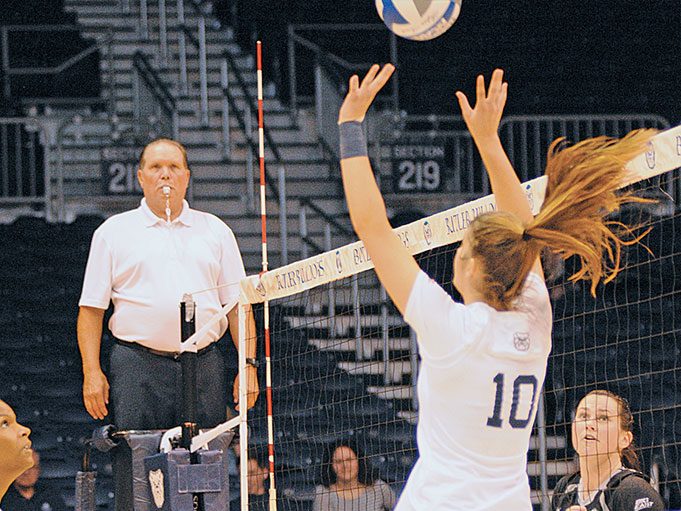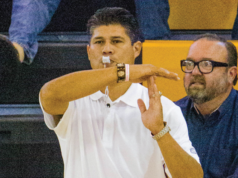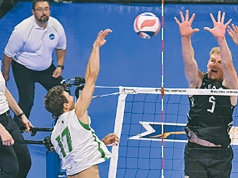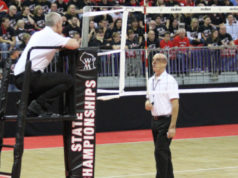One of the biggest areas of concern during a match for coaches and referees is ballhandling. Ballhandling decisions can make or break a match. In recent years, volleyball has adopted a more lenient “keep the ball flying” philosophy, which discourages referees from interjecting themselves into the match. This philosophy allows players to make more spectacular plays and gives the crowd more to cheer about during a match.
However, some referees continue to whistle ballhandling decisions differently due to a conflicting philosophy on how they think the game should be played, or through a misunderstanding of the current keep-the- ball-flying approach.
This is a critical area where coaches and referees may face challenges during a match. Common scenarios:
- Referees whistle a match too tightly because they believe the game has become sloppy and setters are not being trained as they were in the past.
- Referees do not make any ballhandling calls because they feel that will keep the ball flying and allow the teams to decide who will win the match.
Neither of those extremes is appropriate and referees should adapt to the current accepted philosophy for ballhandling: 1) If a player makes an athletic/spectacular play on the ball and there is a marginal ballhandling fault, allow play to continue; and 2) If a player is in good position to set the ball and they make poor contact leading to an egregious double, whistle the fault. Personal philosophies should not take precedence over these two points.
But is it ever really that clear throughout the course of a match? Of course not. In some matches one setter has really good hands and the opposing setter’s ballhandling is questionable, at best. In other matches, one coach wants all doubles whistled while the other doesn’t seem to care about ballhandling. A combination of what coaches expect, how players react to calls and no-calls, whether a match is closely contested and what personal opinions referees bring into a match can lead to a ballhandling nightmare. Sound judgment is needed for all of the other balls that are set — those that do not fall under the athletic play or egregious categories. Unfortunately, there are no set guidelines we can provide when training referees in this area. It comes down to repetition and court time, being open to feedback, keeping up with the current directives and being self-reflective about decisions. Please keep in mind, the perfect match will likely never be attained regarding ballhandling decisions because there are always a few that we, or others, may question.
A further area of concern for coaches and referee partners is a first referee that is inconsistent with his or her ballhandling decisions. Inconsistent judgment can be very frustrating for referee who has to communicate with coaches about the first referee’s decisions. Referees should only whistle faults that they see. Awkward body positioning, non-setters vs. setters, ball spin and the score of a set/match should not be factors considered for whistling a fault. Yes, this can lead to an occasional coach or player outburst, but in the long run it will make you more consistent in your judgment when you whistle only what you actually see. What it comes down to in the end is that everyone wants consistency from the start of the match until the end; that is a higher priority than the actual line of acceptable ballhandling you have established (tight or loose).
So, how can we improve in this area to minimize our impact on the game? Here are some ideas to help you get better at identifying which calls should have been whistled and those that should not have been whistled.
Conduct a thorough prematch meeting with your partner
Consider including something about the line you typically establish for ballhandling and how you can get confirmation of calls and no-calls.
Conduct an honest post-match debrief with your partner and discuss ballhandling decisions
It is important to reflect on the match while it is fresh in your mind and be willing to recognize that you may not have been correct in all your decisions.
Pay attention to the reactions of participants (coaches and players)
Important to note: Do not whistle a fault because they disagree vocally or through hand gestures; at the same time, just because nobody reacts negatively to your decisions, do not assume that you are whistling a great match.
Attend a PAVO or USAV referee training camp to receive feedback from experienced National-level referees
They can break down a match as an unbiased, knowledgeable observer and help you understand certain situations where a call or no-call would have been the better option.
Continue to self-evaluate your performance and establish a “marginal zone” (what we often call the “gray zone”) that you are comfortable with and can sustain throughout an entire match
This can be difficult and take many years to accomplish, but don’t give up on being the best referee that you can be. The next time you take the stand as a first referee, be patient and careful about when you insert yourself into the match by whistling that first ballhandling fault. Be sure that the first time you whistle is a level that you are prepared to call for the entire match. If you have chosen an appropriate marginal zone and can maintain consistency, participants will feel as though a fair match was called by the referee.
What's Your Call? Leave a Comment:
Note: This article is archival in nature. Rules, interpretations, mechanics, philosophies and other information may or may not be correct for the current year.
This article is the copyright of ©Referee Enterprises, Inc., and may not be republished in whole or in part online, in print or in any capacity without expressed written permission from Referee. The article is made available for educational use by individuals.


















